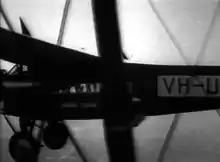1931 Avro Ten Southern Cloud disappearance
The Southern Cloud, registered VH-UMF, was one of five Avro 618 Ten three-engined aircraft flying daily airline services between Australian cities for Australian National Airways in the early 1930s.[1]
 Still from film footage of the Southern Cloud, photographed from another aircraft | |
| Accident | |
|---|---|
| Date | 21 March 1931 |
| Summary | Severe weather |
| Site | Snowy Mountains, New South Wales, Australia 35°59.967′S 148°19.775′E |
| Aircraft | |
| Aircraft type | Avro 618 Ten (license-built Fokker F-VIIB/3m) |
| Operator | Australian National Airways |
| Registration | VH-UMF |
| Passengers | 6 |
| Crew | 2 |
| Fatalities | 8 |
| Injuries | 0 |
| Survivors | 0 |
On 21 March 1931, the Southern Cloud departed at 8:10 AM from Sydney for Melbourne. On board were six passengers and two crew, including pilot Travis "Shorty" Shortridge.[2] Weather conditions en route were hazardous and much worse than predicted. The aircraft never reached its destination and disappeared.[3]
The search for the missing aircraft lasted 18 days and involved over 20 aircraft. No trace of the missing aircraft was found. Airline co-owner Charles Kingsford Smith joined the search and "may have flown over the crash site, but with the aircraft having burned it would be very difficult to distinguish from the air and so the discovery wasn't made."[2]
It was Australia's first major airline disaster. Australian National Airways folded later that year as a result of both this and another loss. A film inspired by the accident, The Secret of the Skies, was released in 1934.
The Southern Cloud's fate remained a mystery for 27 years until 26 October 1958. On that day, Tom Sonter, a worker on the Snowy Mountains Scheme, made a chance discovery of the wreck. The crash site was in heavily timbered mountainous terrain within the Snowy Mountains about 25 km (16 mi) east of the direct Sydney–Melbourne route. Investigations concluded that the severe weather conditions at the time of the flight most likely contributed to the crash.[3]
A man named Stan Baker had been booked to fly on the fateful journey but cancelled and travelled by train instead. As a result of the aircraft's disappearance, he harboured a lifelong fear of flying – which was proved justifiable when he was killed in the 1950 Australian National Airways Douglas DC-4 crash.[4]
In Don Bradman's book Farewell to Cricket he mentions that he flew in Southern Cloud with pilot Shortridge from Adelaide to Melbourne, then to Goulburn not long before the tragedy. He described the trip as a 'bumpy journey'.[5]
References and notes
- "Southern Cloud clock". National Museum of Australia. Retrieved 13 September 2008.
- ABC Television – 7:30 Report 30 October 2008
- "Into The Abyss & Back" (PDF). Flight Safety Magazine. July–August 2006. Archived from the original (PDF) on 9 August 2008. Retrieved 8 May 2009.
- Simpson, Colin (1961). Show Me A Mountain: The Rise of an Australian Company, Ampol. Sydney: Angus & Robertson. p. 151.
- Bradman, Donald (1950). Farewell To Cricket (1st ed.). Sydney: Hodder & Stoughton. p. 35.